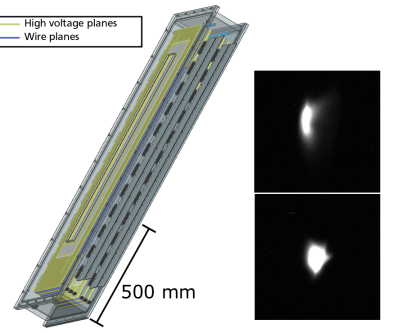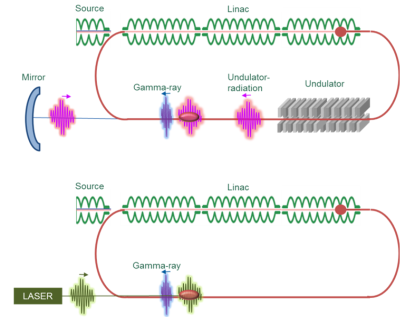Laser Compton backscattering (LCB) is a perfectly suited experiment for an energy recovery linac (ERL). The LCB setup under installation at S-DALINAC will be a proof-of-principle experiment. The laser beam will be set up to enter the straight section of the third recirculation beam line collinearly with the electron beam resulting in a head-on collision with it. The backscattered photons will travel through the straight section, will be collimated for a definition of the Compton-scattering angle, and will subsequently be measured in a dedicated detector with high energy resolution.
The electron beam will have a maximum energy of 100 MeV. Colliding with a laser with a photon energy of 1.2 eV this yields a maximum energy of 180 keV for the backscattered photon in the case of head-on-collision. The interaction point will be a challenge. An electron beam with a transversal size of 100 µm or less will collide with a laser beam of the same size. To ensure a long-term stable operation a precise alignment as well as a stabilization system will be needed. In particular, the setup will be used as a diagnostic system for the electron beam of the S DALINAC. The parameters measured (e.g. energy and energy spread of the photons) will be a probe for the parameters of the electron beam. Further investigations will be done on possible upgrades of the LCB setup, e.g. a further modification of the magnetic lattice to guarantee a smaller transversal beam size at the interaction point to increase the photon flux. The layout of an optional future system at MESA optimized for higher photon flux will be studied.
Betreuer/in: Dr. Michaela Arnold
Information on electromagnetic excitation modes of atomic nuclei is indispensable for an improved understanding of nuclear structure. Electron-scattering reactions with high energy resolution as performed at the QCLAM spectrometer at the S-DALINAC can provide this information. As a continuation to the upgrades to the QCLAM spectrometer, especially its focal plane detector system, we are presently constructing a new focal plane multi-wire drift chamber (MWDC, see figure). Within this project, the newly built chamber will thoroughly be tested and characterized.
During the electron-scattering experiments at the QCLAM spectrometer, position drifts of the electron beam on different time scales can severely limit the energy resolution to be achieved. Within this project, we will install an OTR (Optical Transition Radiation) target directly behind the scattering target to monitor the position of the electron beam. The correction of the beam position is done by electro-magnetic steering elements located directly in front of the scattering chamber. The energy at the scattering target can further be stabilized with an RF monitor next to the target chamber. Beam dynamics simulations and further measurements of beam parameters will support this project.
Betreuer/in: Dr. Volker Werner
ERL facilities are capable of providing high-brightness electron bunches with very high repetition rates in the range of hundreds of MHz and higher, thus they are excellent drivers for Compton backscattering based gamma-ray sources. However, since the scattering process can degrade the electron beam quality, the question arises under which conditions and up to which gamma-photon energy the recovery of the electron-beam energy can still be guaranteed. These questions need to be investigated in a dedicated manner with the goal to optimize the performance of future gamma-sources (see figure).
A dedicated investigation of the merit of a high-flux Compton backscattering gamma-source at MESA composes of conceptual and experimental work.
A first PhD-work has already been devoted to the identification of the desired properties of the gamma-rays for a future pilot experiment, corresponding optimum scattering configuration (Compton) and location at MESA. The analytical and numerical evaluation of the scattering with an external laser or a beam-based radiation-source regarding gamma-ray properties and energy recovery process are final goals of this PhD-work. A second, subsequent PhD-work is needed to prepare, carry out and evaluate the key-validation experiments at MESA and S-DALINAC, which have been identified taking advantage of the findings of the first half of the first PhD-project. In this context the experimental opportunities provided by the S DALINAC are very attractive, particularly when operated in ERL-mode and using an external laser.
The beam quality monitoring of extracted beams, transported to the experiment halls, is of great importance to ensure high efficiency data recording by experiments. Beam monitoring devices could be used for online monitoring of beam halo, beam position on the target as well as the beam time structure. For not too high intensity runs precise time-zero (T0), which is essential for the excellent particle identification produced, e.g., in electron-nucleus collisions, could also be measured. The required time precision for such a T0-reference system should be better than 50 ps in a situation where two beam bunches are separated by 334 ps as in the S-DALINAC.
One of the concepts under development is the Ultra-Fast Silicon Detector (UFSD) technology. The main advantages of UFSD are: (i) excellent timing properties with time precision as good as 30 ps; (ii) tracking capability of silicon sensors (tens of µm precision); (iii) availability of material to cover large area; (iv) commercially available production; (v) low production costs; (vi) lower material budget (detector thickness can be as thin as 100 µm).
To take full advantage of the properties of the UFSD technology, custom-made readout electronics is needed. Next-generation detectors with improved radiation hardness of this technology are in preparation. The experimental setup needs to be optimized. The stable long-term sensor performance and time precision better than 50 ps need to be demonstrated.
A permanent multi-functional test setup at the S-DALINAC has been installed in the first funding period of the GRK 2128 (see figure) and provides excellent conditions for research and development of detectors for timing applications, especially for minimum ionizing particles.
Betreuer/in: Prof. Dr. Tetyana Galatyuk
Institut für Kernphysik

GRK 2128 Accelence
Strahl-Target-Wechselwirkung
Die notwendige Strahlqualität in Beschleunigern wird letztlich durch Anforderungen der Experimente festgelegt. Die Strahlemittanz wird hauptsächlich durch die Teilchenquelle und den Injektor vorgegeben. Zusätzlich kann die anfängliche Energieverteilung nur noch durch Strahlkollimation, die Hintergrundstrahlung, Aktivierung und Strahlleistungsverluste verursacht, oder durch hochentwickelte Dämpfungs- oder Kühlungsmethoden, die in kurzen Beschleunigern mit wenigen Durchläufen wie ERLs nicht angewandt werden können, reduziert werden. Experimente und Beschleuniger sind in ERLs noch stärker miteinander verschränkt, da der Strahl nach dem Experiment wieder in den Beschleuniger zurückgeschickt wird. Deshalb ist ein sorgfältiges Design von experimentellen Aufbauten notwendig, um den Strahl nach der Interaktion noch im Linac auffangen zu können. Das Projektgebiet E von AccelencE befasst sich mit dieser Aufgabe sowie mit Untersuchungen zur Verbesserung der Auflösung in Detektoren.



